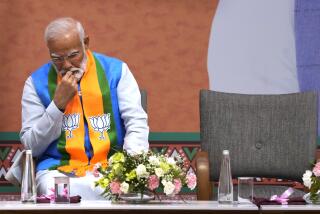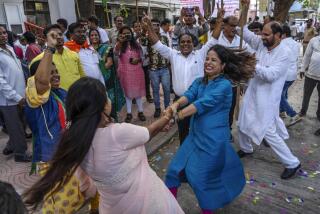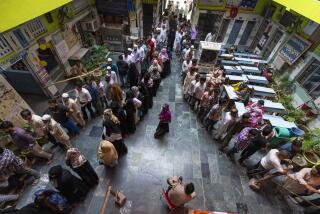NEWS ANALYSIS : Sympathy Vote May Bring Gandhi’s Party the Majority He Wasn’t Expected to Win : Martyrdom: ‘The people will not pardon this at the polls,’ a candidate says.
- Share via
NEW DELHI — The flag-draped coffin containing the body of former Prime Minister Rajiv Gandhi was placed on display Wednesday at the same site occupied six years earlier by the coffin of his assassinated mother, and the legend that now will radically alter India’s scarred political landscape began to grow.
“He knew very well that he was vulnerable, and he was prepared to sacrifice,” said Maganbhai Barot, an elderly friend of Gandhi’s mother, Indira, and one of the Gandhi party’s candidates in the election campaign that took the 46-year-old leader’s life Tuesday night.
“In our country, nothing appeals to or shakes the people more than sacrifice,” Barot said. “Martyrdom is something that captures the mind, and I believe, in this case, it is all the more tragic because he died so very young.
“Make no mistake. The whole nation will mourn his death. The people will not pardon this at the polls.”
Emphasizing that message was the selection Wednesday of Gandhi’s widow, Sonia, to succeed him as president of the Congress-I Party, a surprise move that analysts say will ensure a wave of election sympathy for the party.
And as Gandhi’s body lay in the home that is now a memorial to the father of the Indian nation--his grandfather, Jawaharlal Nehru--the latest victim of an assassin’s attack on India’s longest-serving political dynasty already had been transformed by death into a hero.
In fact, according to analysts, businessmen, common folk and even some of Gandhi’s political enemies, it was clear Wednesday that the youngest of the ruling Gandhis, like his mother before him, will manage to achieve in death what few believed he could in life--win a clear majority in the crucial parliamentary elections that triggered his assassination.
“The whole political picture of the country has changed overnight,” said Kushwant Singh, a Sikh author and frequent critic of the Congress-I. “The Congress almost certainly will win by a very large majority now.
“In the next round, there will be a big swing on account of the sympathy vote, and it will be at the expense of the Bharatiya Janata Party, which was the biggest single challenger to Rajiv Gandhi’s return to power.”
Gandhi’s death, by an assassin’s bomb at a rural election rally, forced the postponement of India’s staggered, three-day polling, which began Monday and was to conclude this Sunday.
The continuation of the voting, already India’s bloodiest ever with at least 200 dead, is now scheduled for mid-June. But already the pundits are rewriting their versions of India’s political future, a future that most had predicted could have brought to power the nation’s first Hindu revivalist government.
Before the bombing, many of those political analysts had given an edge to the Hindu-revivalist Bharatiya Janata Party, which waged an effective grass-roots campaign for the votes of India’s 750 million Hindus in an effort to politically unite the deeply fractured nation along religious lines for the first time in history.
“The BJP is now finished this time,” said a New Delhi businessman who had come to the shrine called Teen Murti Bhawan to pay his last respects to Gandhi.
According to the businessman, most urban, educated, middle-class Hindus had planned to vote for BJP candidates this week, largely because Congress-I, which governed under Gandhi’s leadership for five years, and the two splinter governments that briefly replaced the Congress-I after its defeat in November, 1989, had all failed to pull India back from economic and social chaos.
“But it’s all changed now,” the businessman added. “It’s all a sympathy wave now. Rajiv is a martyr, and martyrs are very good campaigners in India.”
Gandhi’s 106-year-old party will suffer from the loss, however. Despite the widespread prediction that the Congress-I will romp to victory--just as Rajiv Gandhi did in December, 1984, two months after his mother’s assassination--there is no obvious replacement for Gandhi. And most analysts fear that the loss of a man who had campaigned principally as a symbol of stability, unity and progress will only serve to herald an era of even greater chaos and economic decline.
“As in any dynasty, there always comes a point in time when succession is a problem,” said one European diplomat in New Delhi. “And the Congress is now at that point. They’ve simply run out of Nehrus for the moment.”
But not Nehru in-laws.
In a surprise decision late Wednesday that most Indian analysts viewed as a shrewd move to ensure both a sympathy wave at the polls next month and the perpetuation of the Gandhi name, the Congress-I leadership unanimously chose Rajiv’s Italian-born widow to head the party.
There wasn’t much competition. Although Sonia Gandhi has never held elected office, the remnants of the party leadership, consisting largely of sycophants fiercely loyal to the Nehru family, formed a presidential slate so lackluster that many mourners who made their way to the shrine Wednesday were chanting, “Sonia Gandhi for President! Sonia Gandhi is our new leader!”
Sonia Gandhi has become an Indian citizen. She speaks fluent Hindi, and, in fact, she campaigned more intensely than her husband in his home district of Amethi this year. But the fact that she is not a candidate in the parliamentary elections all but rules her out as a possible prime minister after the voting, although controversy reportedly continues within the party over whether she should vie for her husband’s seat when the voting continues next month.
And the voters, interviewed outside the home where Gandhi lay in state, agreed with the analysts that without a powerful and active leader, the Congress-I, which traditionally has been run more like a monarchy than a democracy, will be as vulnerable to internal collapse as the two governments that briefly replaced it.
Former Prime Minister Vishwanath Pratap Singh, who succeeded Gandhi in 1989 as the head of a weak coalition that included both the right-wing BJP and a bloc of India’s Communist parties, fell from power in part because his government was sabotaged by one of his own party leaders, Chandra Shekhar. Shekhar in turn was forced to resign three months later when the Congress-I withdrew its coalition support from his splinter party.
Never before has a Congress-I government been led by a non-Nehru family member. And in such a Byzantine political arena as India’s parliamentary democracy, New Delhi’s best political analysts concluded Wednesday that the Congress-I government now expected to emerge in June will be as weak as its leadership, rather than as strong as its majority mandate.
That in turn could fuel disintegration in the countryside, where there are deep divisions between linguistic and ethnic groups.
“The negative aspect of all this is I don’t see any other leader who will have an appeal all over the country in the way that Rajiv Gandhi did,” said Cho Ramaswamy, a prominent analyst based in the southern state of Tamil Nadu, where Gandhi was killed.
“The positive side, of course, is that one-time opponents like Chandra Shekhar and V. P. Singh will now drift back toward the Congress-I. The main reason they left was they knew that with Rajiv Gandhi as the leader, they could never acquire the prime minister’s chair. But again, none has that national appeal of this man who is now gone.”
For party elders such as Maganbhai Barot, who served as a deputy finance minister under Indira Gandhi in the early 1980s, such concerns and potential crises, although troublesome, are manageable ones.
“This is a country which has, for thousands of years, given leaders in crises,” he said, smiling as he walked toward the long, snaking line of mourners.
But outside the foyer where Gandhi’s coffin was piled high with rose petals, marigolds and sacred branches, there was an altogether contrary image, one far more typical of the party’s less literate and less faithful who flocked to the shrine throughout the day.
“I have lost my son,” an old woman was wailing, over and over.
India’s Political Portrait
Indians voted Monday, and will continue the balloting June 12 and 15, to elect the Lok Sabha, the decision-making lower house of Parliament. Here’s a look at party control by state.
The Major Parties
* Congress-I Party: A centrist party that is the oldest, richest and best-organized of all parties. It led India’s independence struggle against British colonial rule and is widely perceived as secular and pro-liberalization. Congress has ruled India for all but six of its 44 years of independence.
* Janata Dal: A pro-farmer centrist party with the bulk of its support in the rural areas of northern India, Janata Dal is an offshoot of the Janata Party, which defeated the Congress-I Party in 1977. The Janata Dal contested its first election in 1989, winning 143 out of 543 seats. It formed a coalition government with support from the Bharatiya Janata Party, Communist Party of India and three regional parties, collectively called the National Front.
* Bharatiya Janata Party (Indian People Party) : A pro-Hindu party traditionally supported by the trading community in urban areas. The party has risen spectacularly since 1984, when for the first time since independence, it won 2 out of 542 seats. In 1989 it won 85 out of 543 seats.
* Janata Party-Socialist: A splinter group of the Janata Dal, Janata Dal-Socialist was formed last November by caretaker Prime Minister Chandra Shekhar, who is heading the interim government since his resignation in March.
Under federal rule: Jammu and Kashmir, Himachal Pradesh, Punjab, Haryana, Rajasthan, Madhya Pradesh, Tamil Nadu, Assam
Congress-I Party: Maharashtra, Karnataka, Andhra Pradesh, Tripura, Arunachal Pradesh, Mizoram
Janata Dal: Bihar, Orissa, Manipur
Bharatiya Janata Party:
Communist Party of India: Kerala, West Bengal
Local Party: Goa, Gujarat, Meghalaya, Nagaland, Sikkim
State government dissolved pending elections: Uttar Pradesh
More to Read
Sign up for Essential California
The most important California stories and recommendations in your inbox every morning.
You may occasionally receive promotional content from the Los Angeles Times.













